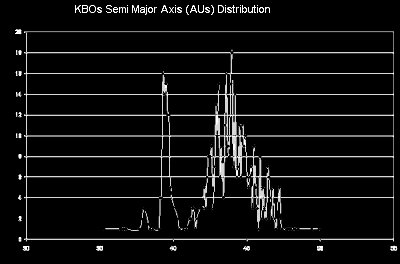 "
"
Through the course of this web-page, I will be examining the current
status quo of the solar system, and how a tenth planet might be accomodated
within the known framework. I will present arguments proposed by
scientists about the Kuiper Belt Objects, and how their trajectories might
hold the clue to the presence of a massive undiscovered body among the
comets.
I will question the reason why Alan Alford became sceptical
about the existence of a Nibiru-like tenth planet. Finally, I will
discuss the weird behaviour of the Pioneer spacecraft, and how this unexpected
anomaly might force astrophysicists to rethink the solar system's physical
properties.
The KBO Perturber
The hunt for planets outside our solar system (known as 'extra-solar' planets) is providing a growing data base of planetary behaviours that will allow scientists to build new models about how the solar system formed. Few expect the current understanding to last for long. Already, many of the new planets exhibit unexpected behaviour indicating that our own Sun's planetary system need not provide the blue-print for the entire galaxy.
Research conducted by Geoffrey Marcy, et al, has shown that planets circling a star can be locked into resonant orbits. A second planet discovered around the star Gliese 876, a small M-type star 15 light-years from Earth, was found to orbit the star in exactly half the time it took for the previously discovered planet to do so:
"Such resonances have been found within our own solar system. Neptune and Pluto are locked in a 3:2 resonance, where Neptune orbits the Sun three times for every two circuits by Pluto. In addition, three of Jupiter's largest moons -- Io, Europa, and Ganymede -- orbit the planet in a 4:2:1 resonance. The resonance between the two [extra-solar] orbiting planets is among the most exciting planet detection discoveries to date," said Jack Lissauer, a planetary dynamicist at NASA's Ames Research Center. "Questions about planetary migration and gravitational influence are still very much unsolved," Lissauer noted." (1)
This last point is important to our investigation into the question of Planet X. Arguments levelled against the existence of Planet X, based upon the current models of the solar system's emergence and development, may be on shaky ground. We simply don't know enough yet to rule anything out. But the other fascinating point about Marcy's discovery is the question of resonance:
"We don't know how they could have gotten into that configuration," said Marcy. "These two resonate planets [sic] seem to be humming in harmony," said Fischer. "They are like two harmonic notes on a stringed instrument." (2)
This kind of resonance pattern applies to the Kuiper Belt Objects (KBOs); small celestial bodies orbiting in an extended belt beyond Neptune. Theo Kermandis, an engineer with an interest in the existence of Planet X, recently suggested that I study the orbits of the known KBOs to see if resonant patterns might indicate the presence of Nibiru within, or beyond, the Kuiper Belt (3). He provided some data and analysis that suggested to him that an undiscovered body may indeed be interacting with some of the KBOs, but that its orbit would seem to lie well within the parameters normally suggested for Nibiru. He wondered whether a clearer picture would emerge over time, as the database of KBOs increased, perhaps leading to the discovery of another planet in the solar system. Theo outlined his approach:
 "
"
I plotted
out the known KBO distribution and attempted to compare that with the distribution
of asteroids as shown. A couple things to note:
a) The KBO count could be too low to get meaningful results but trends in the data could be discerned.
b) Asteroids cluster around specific resonances while avoiding others... because they are dynamically stable.
c) The dynamically unstable resonances can be a more acurate indicator for projecting possible relationships between orbiting bodies, because these notches in the graph are very well defined (otherwise known as Kirkwood gaps). Whereas stable or semi-stable orbits are shown as broad peaks.
There is a strong Kirkwood gap with resonance 2:1 as well as 3:1, 5:2 and 7:3. Given these resonances, this will then be used to predict the semi-major axis of a possible influencing body." (3)
Intrigued by Theo's suggestion, I contacted an expert on KBOs at Harvard about the potential for this approach. His reply was encouraging in terms of the application of Theo's method, although in this case Neptune appeared to be the dominant influence:
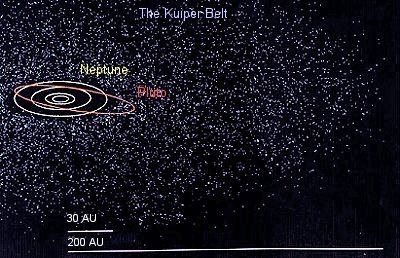
"There is a lot of dynamical structure in the distribution of Kuiper
belt objects. As your friend pointed out, there are particular values
of semimajor axis in the region beyond where there appear to be concentrations
or absences of objects.
"Indeed, these are often associated with what are called mean motion resonances. Here, they are resonances with Neptune. They occur when the orbital period of one body is related to that of another body by a ratio of integers (3:1, 2:1, etc).
"The resonances are important because the repetitive influence of the planet can stabilise or destabilize the orbit of the small body." (4)
The KBO data appears to be consistent with a resonant pattern with Neptune, but it turns out that this generalisation is not universally adhered to. In fact, one object beyond Neptune behaves very oddly indeed.
2000 CR105
In 2000 a team from Harvard discovered an object whose bizarre orbit could not be explained by invoking the influence of Neptune. The discovery of the Kuiper Belt Object '2000 CR105' reignited the debate about the presence of a massive body perturbing small celestial bodies beyond Neptune and Pluto. It has an orbital period of 3300 years, not dissimilar to Sitchin's Sar of 3600 years for Nibiru, and is highly eccentric (5).
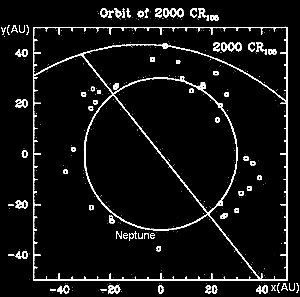
Its properties are so bizarre that major questions are being asked about the structure and formation of the outer reaches of the solar system:
“...It's now clear that 2000 CR105 has a highly eccentric orbit that stretches out to roughly 400 a.u. — more than 10 times Pluto's mean distance from the Sun and far larger than that of any known Kuiper Belt object. But more puzzling to dynamicists is the orbit's perihelion distance. At 44.5 a.u. (6.7 billion km), it is well beyond the perturbing influence of Neptune, whose gravity has flung countless other bodies out to the solar system's most distant fringes. So how did 2000 CR105 end up stranded out there?
"The orbit of 2000 CR105 is dynamically chaotic....Perhaps the Kuiper Belt formed with numerous planet-size bodies in its midst, which wreaked orbital havoc before themselves being heaved out of the region. Or Neptune itself may have ventured farther out before settling into its present orbit.
"And though the notion is highly speculative, a massive perturber may yet await discovery beyond the Kuiper Belt's known boundary. Matthew Holman notes that a body the size of Mars 200 a.u. away could easily have escaped detection to date.” (6)
The Kuiper Belt is classically thought to extend out to about 200AU (7). So an elliptical orbit that extends to 400AU places '2000 CR105' between the Kuiper Disc and the Oort Cloud (which starts about 2000AU away, according to theorists). If this object had a 'normal' orbit at 400AU it would circle the Sun every 8000 years or so, yet its actual elliptical orbit achieves a revolution around the Sun in less than half the time.
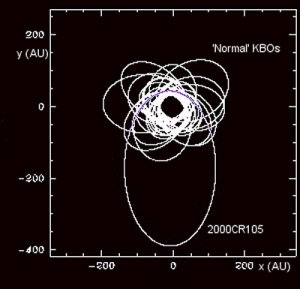
In itself, this has important repercussions for the possible orbit of Nibiru. Based on the precedent of this eccentric orbit, we can in turn potentially extend the aphelion distance of Nibiru, perhaps towards the inner boundary of the Oort Cloud.
Dr Holman's quote about the possibility of a planet-sized body beyond the Kuiper Belt is also encouraging. Despite the negative results for Planet X given by the IRAS search of the sky, another planet could yet await discovery. It need not lurk at the very fringes of the Sun's influence, either.
To satisfy myself that a more conventional explanation for 2000 CR105's dynamically chaotic orbit had not been established since its discovery 2 years ago, I contacted Dr Holman: Its origins, he noted, still remain a mystery and the subject of much speculation (8).
I think that Theo's proposal about the resonance of the Kuiper Belt Objects deserves further consideration: There may be more scattered Kuiper Belt Objects whose perihelion distances lie beyond the point where Neptune's influence can be invoked as an explanation for their behaviour. If these more distant objects were also to show a resonance pattern, but this time with an unknown perturber beyond the Kuiper Belt, then the position of this planetary body may be readily verifiable in the not too distant future (the first KBO was only discovered in 1992 (9)).
This would assume, of course, that Planet X is 'behaving itself'. But what if its orbit is itself erratic, or dynamically unstable?
Resonance
The idea of ''resonance' is an intriguing one. One assumes that it is an effect that emerges over time as planets 'shepherd' comets, asteroids or even moons. As we have seen, Geoffrey Marcy's planet-hunting team from Berkeley, California have found two planets whose orbital periods resonate together. Evidently, this effect is a strong one, yet the astronomers seem surprised by this. Presumably, although resonance is noted, it is not predicted for planetary bodies. In other words, our current understanding of celestial mechanics does not lead us to presume that the planets will fall into orbital patterns whose periods become integer ratios of one another. Is that because most of the planets in our solar system quite clearly are not in resonance with one another? Because they are quite evidently more chaotically arranged, we have never assumed that resonance is 'the norm'.
Let's follow this line of thought for a moment. The ancients were not averse to the idea that there was a natural harmony at work in the heavens. Pythagoras, for instance, believed that there was a 'dynamic harmony' in the universe, and that the constant movement of the planets and stars created a metaphysical 'music' that was detectable by those with a mystical understanding of the universe (10).
I'm not about to suggest that we could scientifically qualify this belief, but the idea of a celestial harmony at work is an interesting one nonetheless. Perhaps, then, there is a force at work within celestial mechanics that creates harmony between the 'celestial spheres', one that scientists have not discovered yet. But why wouldn't they have? Because, simply, the evidence from our solar system does not immediately support the idea of a universal resonance between the worlds. The planets simply don't behave like that.
But we now know that they can do elsewhere. Perhaps our solar system is the exception, rather than the rule. If more double/triple planet star systems are discovered that exhibit the same kind of resonance as that found in the planetary system of Gliese 876, then our understanding of the influence of planets over one another would have to be reconsidered.
I think this could be a distinct possibility. In fact, I would go so far as to say that I would predict such an effect. You see, I think that this harmonic resonance is not found in the solar system as much as it should be because the solar system has recently been disturbed. The natural harmony, or resonance, between most of the planets of the solar system no longer exists. Over time, I suspect that the resonance would once more be achieved, but the current relative 'chaos' within the pattern of planetary orbits around the Sun indicates the presence of another planet. One whose orbital pattern is a disruptive, rather than cohesive, influence. In other words, Nibiru.
Order from Chaos
To explain the orderly alignments of the planets within the solar system, astrophysicists have traditionally argued that the planets formed in their present orbital configurations, obeying 'Bode's Law' right from the word 'go'. This is partly due to the fact that we don't have planets flying around our ears, as one might have thought if things had begun more chaotic in the past. In other words, the accepted physical models are based upon Newton's Laws, that the planets will keep going in a given orbit indefinitely, unless directly perturbed by another planetary body.
But the resonance effect implies a self-regulating principle at work, one that would alter the planetary orbits over time as they harmonise with one another. As such, if resonance turned out to be a common feature of planetary systems, we could no longer surmise a regularity for the early solar system based upon its current appearance. Would this be so surprising? After all, other findings from extra-solar planets have already sufficiently rocked the boat for us to question many previously held assumptions (11).
In the last few years evidence has emerged that paints a more violent picture of planetary formation. Our Moon, for instance, seems to have been formed following the collision of a Mars-sized body with the Earth. The resultant debris formed a ring around out planet that then coalesced into our over-sized satellite. NASA scientists studying data obtained from the Apollo missions found similarities between the mineral compositions of the Earth and the Moon, that could only be equated with a collision having occured after the formation of Earth's inner iron core:
“Analysis of data from NASA’s Lunar Prospector spacecraft has confirmed that the Moon has a small core, supporting the idea that the bulk of the Moon was ripped away from the early Earth when an object the size of Mars collided with the Earth” (12)
The solar system was subject to an intense barrage of debris 3.9 billion years ago, some time after its initial formation. The Earth received 'thousands of giant impacts', many much larger than the one that killed off the dinosaurs. The cataclysmic onslaught produced 'continent-sized craters and liberated enough heat to vaporise oceans' upon the Earth, and this event is known to scientists as the 'late, great bombardment' (13).
Given the evident violence attributed to the early solar system, it seems unlikely that an orderly distrbution of planets existed at that time, particularly if the Moon really was formed by a collision between the Earth and a 'Mars-sized' body. These events mirror those described by Zecharia Sitchin in his book 'The Twelfth Planet' (14), derived as they are from Babylonian and Sumerian cataclysmic creation myths like the Enuma Elish. Despite the violence of the early solar system, the current picture is relatively tranquil. The planets may not be resonating with one another like they do around Gliese 876, but they aren't about to crash into one another either. Somehow, order has been derived from chaos.
Alan Alford
So where does that leave Alan Alford? Alan is an author with a track record of superb scholarship. His first book was based upon a 10 year long study of comparative mythology and argued the case for Planet X, based, in turn, upon the scholarship of Sitchin (15).

During Alford's subsequent efforts to establish whether this eccentrically aligned planet could really have a physical basis, he approached the astronomer Tom Van Flandern. Although Van Flandern was open-minded to the idea that mythology might have its orgins in astronomy, he argued that Earth could not have been derived from a primeval collision between Nibiru and Tiamat (16). Simply put, Earth's orbit should still bring it back to the place of the collision; the Asteroid Belt between Mars and Jupiter. (Sitchin and Alford both contended at the time that Nibiru returned periodically to the asteroid belt during its perihelion passage. Sitchin still does, of course).
Van Flandern summarised the problem in this way:
"A major collision must change the orbit because it changes the momentum of the planet. The new and old orbits must share a common point at the site of the encounter. So a collision cannot take a planet from one circular orbit to another because such orbits have no points in common." (16)
To Alford, this appeared to deal a killer blow to the idea that Planet X might lie at the source of ancient creation myths. (Indeed, Alford completely changed his mind about the orgin of mythology, taking up Van Flandern's 'Exploding Planet Hypothesis' instead). But Van Flandern's arguments are not water-tight.
The primordial battle between Nibiru and Tiamat occurred, we are led to believe, not long after the formation of the solar system. There is therefore no fundamental difference between this cataclysmic event and other similar cosmic collisions that may have occured when the solar system first formed. Van Flandern's arguments are based upon the theory that the solar system has never been a violent place, at least in terms of collisions between planets:
"Since the Earth's orbit was almost perfectly circular, Van Flandern thus ruled out any likelihood whatsoever that Earth herself had suffered a major catastrophic collision. In fact, there was no evidence whatsoever that any of the existing planets of the solar system had had their orbits changed in this manner." (16)
Yet, we have seen that the Earth was indeed subject to an intense barrage 3.9 billion years ago, one that is inexplicable in terms of an orderly solar system at that time, and that the Moon itself may have been derived from a terrestrial impact with another planet. Surely such a collison would have disrupted the Earth's orbit? Yet that flies in the face of Van Flandern's argument! Also, shouldn't the Earth have been subject to a regular barrage upon revisiting the collision site over and over again as it moved through the resultant cosmic debris field? Van Flandern's argument would suggest so, surely? And if planets tend to form in a predominantly stable framework, then, at the other extreme, why are many of the orbits of the extra-solar planets found to be so eccentric?
Critically, Van Flandern's argument is inconsistent with the possibilities proposed by Matthew Holman, of the Harvard-Smithsonian Center for Astrophysics, to explain the origin of '2000 CR105'. When Holman speculates that it might be possible that "...the Kuiper Belt formed with numerous planet-size bodies in its midst, which wreaked orbital havoc before themselves being heaved out of the region. Or Neptune itself may have ventured farther out before settling into its present orbit" (6), he is clearly not assuming that planetary bodies will maintain their orbital paths indefinitely, as Van Flandern appears to. In fact, the solar system appears to be an altogether more flexible place. Therefore, Nibiru and Earth need not cross paths. At all.
Of course, not only does this mean that the Earth and the Asteroid Belt might share a common origin without 'sharing a common point', but it also implies that Nibiru need not return to the Asteroid Belt either. A lot can change in 4 billion years...
Alan Alford appears to have dropped the Planet X hypothesis solely on the basis of Tom Van Flandern's critique. The American astronomer's arguments may have some consistency with the historically accepted theory of planet formation in a star system, but that way of thinking is by no means written in stone. Catastrophism appears to be coming back into fashion, as last year's BBC series 'Space' showed quite graphically. Perhaps there are other reasons why Alan Alford prefers Van Flandern's 'Exploding Planet Hypothesis', even when no viable mechanism has ever been proferred to support such a proposal, but the reasons given for his about-turn in 'The Phoenix Solution' are very much a matter of debate. Personally, I think he should have stuck to his guns.
Planetary Energy Levels
Earth has quite evidently attained a roughly circular orbit, despite the previous violence it was evidently subject to. Yet it does not resonate with other planets (although the Moon has a synchronous orbit around the Earth). We also have an increasingly wide spectrum of planetary characteristics to explain in the form of the extra-solar planets. Let me suggest some ideas to show how resonance between planets might come about.
I propose that there a force at work that creates order within planetary systems, even to the point of full planetary resonance, but with the proviso that this drive towards an orbital equilibrium can be disrupted periodically by 'passing traffic'. If I might allude to a chemical metaphor, the energetic arrangements of the planets naturally fall back towards their smallest values over time, like electrons tend to find their most stable orbital configurations within atoms. Only when there is an interaction with another planetary body does the equilibrium become temporarily disturbed, until the solar system once again returns to its lowest possible energy level configuration.
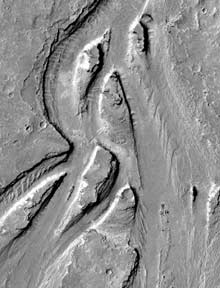
Continuing the analogy, I consider the solar system currently to be in a mildly 'excited state'. The Dark Star returned to the planetary zone about 3.2 million years ago (due, I suspect, to John Matese's mechanism of 'oscultation' (17)), and took on a much more tightly bound orbit as a result of its interaction with the planets and the Sun.
In turn, the planetary binding energies of the known planets changed from their previous equilibrium positions to this excited state. As the orbits expanded in response to the significant tightening of the Dark Star's orbit, the climates of the terrestrial planets cooled down.
Our planet entered a new Ice Age by moving slightly further away from the Sun, and Mars similarly moved towards greater glaciation. Perhaps this explains why scientists are finding evidence of the movement of water across the surface of Mars only 10 million years ago or so, a situation that is not at all consistent with the current climate on Mars (18).
I would like to point out that I am not suggesting that the existence of Planet X need rest upon a new series of physical laws. It could be out there anyway. But what is interesting is the way not only small bodies, but also planets, have been found to resonate with each other.
A purely Newtonian physics does not seem to predict this kind of activity, although it presumably allows for it, and it reminds me of the historical development of our understanding of the atom. Simple atoms could be explained by the application of Newtonian laws, but the greater the complexity, the more the problems emerged. Eventually, laws involving quantum mechanics were introduced, and they could not only explain the simpler cases that Newtonian physics could also deal with, but quantum mechanics allowed chemists to understand the physics of larger atoms and molecules. Could it be the same with astrophysics? Are there greater layers of evidence that invite us to change the way we think about celestial mechanics? There may be reason to think so.
The Pioneer Problem
Readers of my book 'The Dark Star' will be familiar with the anomalous behaviour exhibited by the two Pioneer spacecraft that left the planetary zone many years ago. They have been slowing down, and despite the attention of the best minds at NASA, no one can explain why:
"The puzzle is that Pioneer 10 seems to be slowing more quickly
than it should. Astronomers have detected an anomaly, as if Pioneer 10
were getting an extra pull from the Sun that cannot be explained. No one
is sure what is to blame. A fuel leak, friction from gas in space, thermal
radiation from the spacecraft's batteries and gravity from an unknown
asteroid have all been ruled out. Pioneer 11, launched in 1973, is also
slowing at about the same rate. The Ulysses probe, launched in 1990, is
also affected. Signals from Galileo, now orbiting Jupiter, may also show
the same effect. Scientists are a long way from suggesting that Newton's
law of gravity should be reworked. But the same strange effect seen in
four space probes is making them think..." (19)
I was initially attracted to this anomaly for the same reason that it fascinated the NASA scientist John Anderson (Pioneer 10 Principal Investigator for Celestial Mechanics); that is the possibility that the effect might be indicative of the presence of an undiscovered planet. This possibility appears to have been ruled out, but the riddle remains to this day, resulting in the very real danger that astrophysics might just need to make an adjustment to allow for the effect. Clearly, the current laws of celestial mechanics are not sacrosanct.
I also wonder whether the probes have somehow been affected by this resonance effect I've been alluding to. Perhaps they are being 'shepherded', and that the anomalous changes to their trajectories indicate the beginning of a resonant pattern with other solar system bodies. This might explain why other spacecraft have not been affected in the same way; the effect would be a centralised one regarding the all-powerful binding energies, but would also be subject to local resonance conditions. The Dark Star and its excitation of the planetary energy levels of the solar system may well turn out to be contributory factors involved in solving this puzzle.
So, in the chemical analogy I described earlier, the excited electrons attempting to leave the atom (that represent the Pioneer spacecraft in this case) are subject to the overall excited electron environment (that represents the other solar system bodies). Whilst attempting to escape the solar system, they are simultaneously trying to attain a new, more stable, equilibrium within its dynamic framework. By doing so, they stop behaving Newtonian laws, in the same way that electrons in a complex atom exhibit behaviour not attributable to standard physics.
Surely physicists would have considered this option already? After all, there is much talk of the attempt to reconcile gravity with quantum mechanics. The problem they may have encountered is that they almost certainly would have assumed that the solar system is in an undisturbed state. If I am correct and there is a brown dwarf beyond the Kuiper Belt, then the solar system is not in a simple configuration at all. Different conditions apply, and this would alter the starting point for the physical model.
Ice Ages
The Earth is a relatively tightly bound object, as an astrophysicist at the University of Texas recently pointed out to me. For the orbit of the Earth to be altered by changes to the orbital parameters of a much more distant object, then this object would have to be 'very massive' (20). Of course, if Nibiru is indeed a brown dwarf, then it would amply qualify.
If the brown dwarf's orbit is unstable, possibly because it has only been more closely bound to the Sun since the start of the last Ice Age, then variations in its orbit could factor into that of the Earth's. Without needing to come anywhere near our world. This is the implication of the planetary binding energies as discussed by Hills ((21),see DarkStar13).
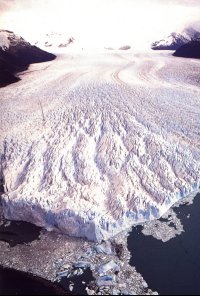
An excitation of the planetary orbits by the intrusion of the Dark Star could have sent the planets into longer orbits, resulting in global cooling and glaciation 3.2 million years ago. This is not a normal state for our world, which is usually completely free of ice for tens, or hundreds, of millions of years at a time (22).
Yet, periodically, glaciation occurs over equally extended periods of time, even creating the extreme 'Snowball Earth' effect 600 million years ago (23). Scientists still do not understand how or why this occured, although several hypotheses have been put forward to explain long-period Ice Ages (24).
A dynamically unstable orbit of a brown dwarf beyond the Kuiper Belt would readily explain such an effect.
Its presence might also allow physicists to remodel the dynamic structure of the solar system, and allow them to understand the current anomalous behaviour of several spacecraft. Finally, the trend towards global warming that our planet has experienced in the last 10-15,000 years might also be attributable to further dynamic changes in the Dark Star's orbit. Its orbit may have become less tightly bound, in turn pulling the Earth slightly nearer to the Sun, triggering the Earth changes that occurred about 13000 years ago. This would also support the conclusion that I have reached that Nibiru currently has an orbit of about 3750 years, not 3600 years.
However, this kind of pattern of instability would not be consistent with a strong resonance pattern between the Dark Star Nibiru and known planets, and other bodies in the solar system. Instead, it would appear to have an overall disruptive effect. I would not expect to see a stable resonance between the Kuiper Belt Objects and Planet X (that I have proposed is a brown dwarf). Instead, I would predict more scattered objects whose behaviour is anomalous, and not tied to any known planet such as Neptune. The exciting discovery of 2000 CR105 should set a precedent for further anomalous finds.
Of course, Theo might be correct instead; if Nibiru has had the same orbit for almost 4 billion years, as Sitchin asserts, then a resonance pattern should have emerged within the Kuiper Belt Objects during that time. But I'm betting that Nibiru's orbit has not stayed the same during that time. Not remotely. Instead, Nibiru is currently causing anomalies and disruption within a system that is trying to attain resonant equilibrium. And that disruption to the harmony of the Celestial Spheres is contemporaneous with the advent of Mankind.
The '5 Inner Planets?'
The ideas expressed in this essay do not represent a bubble in a vacuum. There appears to be a sea-change of opinion within the astrophysics community with regard to the potential for catastrophic activity in the early solar system. A 'new' theory recently generated by theorists speculates that a fifth inner planet existed when the solar system formed, lying within the boundary of of a much larger asteroid belt. The 'Planet V' proposal, one among many 'new ideas coming out in the last few years', considers the possibility that this planet somehow became eccentrically aligned about 3.9 billion years ago (26). This perturbation caused a great shedding of asteroids into the inner solar system, in turn producing the observed 'late, great bombardment' (13); a massive 'spike' of impact activity long after the solar system should have settled down to it present state (generally thought to be stable). The planet was then thought to have crashed headlong into the Sun; (a handy way of getting rid of the evidence, one might say).
When describing the pros and cons of the 'Planet V' hypothesis, some interesting quotes emerge which shed light upon the 'New Reality' within the astrophysics community regarding the early solar system, as the wonderfully named 'Wendell Mendell' of NASA's Johnson Space Center points out:
"This idea and others within the last few years show that the Solar System is filled with all sorts of gravitational resonances...that a lot of potential orbits in the Solar System are chaotic and unstable," Mendell told SPACE.com... The work suggests there's a match up in timing, Mendell said, with asteroids striking the Moon and causing the effects that are seen in the dating of Apollo lunar rocks.
"By thinking that the Solar System was really quite different in a major way with an extra inner planet, we might be able to develop some sort of self-consistent scenario that explains a lot of things. But all this is at the very early stages now," Mendell said. "We're moving into a really new regime where the Solar System is not a static dynamic place from day one to now. It really might have had some nuances and synchronicities associated with it that we have not really tried to exploit before." (26) (my emphasis)
This new way of thinking is exactly the sort of change advocated in
this essay. Theorists are stopping short of saying that this extra
planet was hammered by a planet/sub-brown dwarf that wandered into the
planetary zone from inter-stellar space ("where's the evidence?", they
would say), but the thinking is clearly opening up to lots of new ideas.
Further exploration of the solar system, particularly in the asteroid belt,
might produce new data to help put all these pieces together. One wonders
what scientists would make of future data if it turned out that many of
the asteroids were created out of terrestrial rock 3.9 billion years
ago?
Written by Andy Lloyd, 27th February 2002, and updated 20th March 2002
author of 'The Dark Star' (2005), 'Ezekiel One' (2009), 'The Followers of Horus' (2010) and 'Darker Stars' (2019)
Published by Timeless Voyager Press
References
1) J. Foust "Bizarre new planets puzzle astronomers" Spaceflight Now, 10 January 2000
2) 'Planetary Correctness' Associated Press, 9 January 2001
3) Correspondence from Theo Kermandis, 2 Feb 2002
4) Correspondence from MH, Harvard-Smithsonian Center for Astrophysics, 10 Feb 2002
5) B. Gladman "Evidence for an Extended Scattered Disk?"
obs-nice.fr/gladman/cr105.html
6) J. Kelly Beatty “Big-orbit Object Confounds Dynamicists” Sky & Telescope, 5 April 2001, with thanks to Frank Cordell and Theo Kermandis
7) Alan Stern "Chiron: Interloper from the Kuiper Disk", Astronomy, 22(8): 26-33 August 1994
8) Correspondence from Matthew Holman, Harvard-Smithsonian Center for Astrophysics, 12 Feb 2002
9) Patrick Moore "Atlas of the Universe" p135 Philip's 1999
![]() Philip's Atlas of the Universe
Philip's Atlas of the Universe
10) Michael Baigent "Ancient Traces" p203 Penguin 1998
![]() Ancient Traces: Mysteries in Ancient and Early History
Ancient Traces: Mysteries in Ancient and Early History
11) G. Marcy, P. Butler & L. Cook "Hunting Planets Beyond" pp43-7 Astronomy, 28(3): 42-47 March 2000
12) Joan d’Arc “Space Travellers and the Genesis of the Human Form: Evidence of Intelligent Contact in the Solar System” p29 The Book Tree 2000
![]() Space Travelers and the Genesis of the Human Form
Space Travelers and the Genesis of the Human Form
13) I. Semeniuk "Neptune Attacks!" pp26-9 New Scientist 7th April 2001
14) Zecharia Sitchin " the Twelfth Planet" Ch7 Avon 1976
15) Alan Alford "Gods of the New Millennium: Scientific Proof of Flesh & Blood Gods" Hodder & Stoughton 1996
16) Alan Alford "The Phoenix Solution: Secrets of a Lost Civilisation" pp155-162 Hodder & Stoughton 1998
17) J.J. Matese, P.G. Whitman and D.P. Whitmire "Cometary Evidence of a Massive Body in the Outer Oort Clouds" Icarus, 141, 354-336 October 1999
18) J. Beatty "Scientists Track 'Recent' Flood on Mars" Sky and Telescope 22 Feb 2002
19) D. Whitehouse “Spacecraft pulled by mystery force” BBC, 10 Sept 1998
20) Correspondence from R.F., University of Texas, 29 Jan 2002
21) Jack Hills "The Passage of a "Nemesis"-like object through the Planetary System" The Astronomical Journal, 90(9): 1876-1882, September 1985
22) Illinois State Museum “Ice Ages”
23) ‘Horizon’ BBC2, “Snowball Earth” Shown on 22nd February 2001
24) Kenneth Feder & Michael Park "Human Antiquity: An Introduction to Physical Anthropology and Archaeology" 3rd Ed. p232 Mayfield 1997
25) For the latest Pioneer and Voyager data:
26) L. David "Long-Destroyed Fifth Planet May Have Caused Lunar Cataclysm, Researchers Say" Space.com 18th March 2002 Article on longer available online